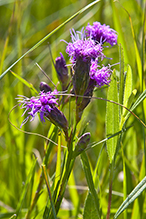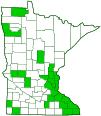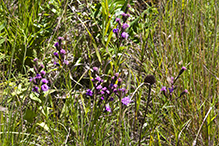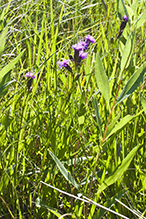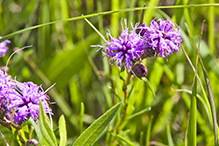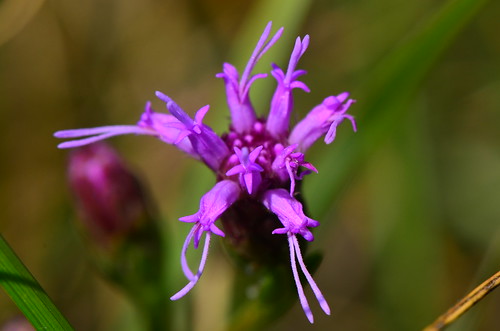cylindric blazing star
(Liatris cylindracea)
Conservation • Description • Habitat • Ecology • Use • Distribution • Taxonomy
Conservation Status |
|
|||||||
| IUCN Red List | not listed |
|||||||
| NatureServe | NNR - Unranked SNR - Unranked |
|||||||
| Minnesota | not listed |
|||||||
Description |
||
Cylindric blazing star is a 8″ to 24″ tall, erect, perennial forb that rises on one or more stems from a globe-shaped corm. The stems are erect, leafy, hairless, light green, and unbranched or sometimes branched near the top. Basal leaves are stalked and form a rosette. Stem leaves are alternate. Basal and lower stem leaves are linear, firm, stalked, 3″ to 10″ long and 1 ⁄16″ to ½″, but usually no more than ¼″ wide. The lowermost stem leaves are small and somewhat sheath the stem. The largest leaves are immediately above those. The upper surface is deep green and hairless. There is a prominent midvein and 2, sometimes 4, narrower, parallel veins. The lower surface is green and usually hairless. The margins are usually light, thickened, untoothed, often turned under, and have a few long, soft, straight hairs below the middle. Middle and upper stem leaves are similar, stalkless, usually linear, sometimes narrowly inversely lance-shaped, and ¾″ to 4″ long, becoming gradually smaller as they ascend the stem. The inflorescence is a single flower head or an unbranched, elongated, 2″ to 4″ long, spike-like cluster of 2 to 28 flower heads at the end of the stem. The heads are loosely spaced and the axis of the inflorescence is easily visible between the heads. They are sometimes stalkless or more usually are held upwards on stiff, ascending stalks that are 1 ⁄16″ to ¾″ long, though usually no more than ⅜″ long. The stalks usually have 1 or more leaf-like bracts at the base. The flower heads are ⅝″ to 1″ wide. The terminal head is usually longer than the others. The whorl of bracts at the base of the flower head (involucre) is smooth, narrowly cup-shaped to nearly cylinder-shaped, and 7 ⁄16″to ¾″ long. The bracts making up the involucre are in 5 to 7 overlapping series. They are broadly egg-shaped–triangular to inversely lance-shaped and taper abruptly to a short, sharp point. They have a narrow, thin, pale or often purple margin. The tips are appressed or strongly ascending, not bent backward. The lowermost bracts are narrower and noticeably longer than the rest. There are 10 to 35 disk florets and no ray florets. Each disk floret has 5 petals fused for most of their length into a tube then separated at the tip into 5 lobes. The corolla tube is ½″ to 9 ⁄16″ long, white at the base grading to pink at the tip. There are 5 stamens concealed within the corolla tube and a long, white, forked style that protrudes well beyond the tip of the corolla tube. There is no fragrance. The fruit is an achene with hair-like bristles attached. The bristles are feather-like (plumose), though this may be difficult to see without a hand lens. |
||
Height |
||
8″ to 24″ |
||
Flower Color |
||
Pink |
||
Similar Species |
||
Rough blazing star (Liatris aspera var. aspera) is a taller plant, 16″ to 48″ in height at maturity. The leaves have 1 main vein, not 3 or 5. There are usually 10 or more flower heads. The involucre is broadly cup-shaped or bell-shaped. The bracts of the involucre appear swollen and have margins that appear torn and uneven. The hairs on the achene are barbed, not plumose. |
||
Habitat |
||
Dry. Prairies, open places. |
||
Ecology |
||
Flowering |
||
July to September |
||
Pests and Diseases |
||
|
||
Use |
||
|
||
Distribution |
||||
|
Sources |
|||
| 4/6/2023 | ||||
Nativity |
||||
Native |
||||
Occurrence |
||||
|
||||
Taxonomy |
|||
| Kingdom | Plantae (Plants) | ||
| Division | Tracheophyta (Vascular Plants) | ||
| Subdivision | Spermatophytina (Seed Plants) | ||
| Class | Magnoliopsida (Dicots) | ||
Order |
Asterales (Sunflowers, Bellflowers, Fanflowers, and Allies) | ||
Family |
Asteraceae (Sunflowers, Daisies, Asters, and Allies) | ||
| Subfamily | Asteroideae | ||
| Supertribe | Helianthodae | ||
| Tribe | Eupatorieae (bonesets, blazingstars, and allies) | ||
| Subtribe | Liatrinae | ||
Genus |
Liatris (blazing stars) | ||
Subordinate Taxa |
|||
|
|||
Synonyms |
|||
| Lacinaria cylindracea | |||
Common Names |
|||
cylindric blazing star cylindrical blazing star few-headed blazing star Ontario blazing star |
|||
Glossary
Achene
A dry, one-chambered, single-seeded seed capsule, formed from a single carpel, with the seed attached to the membranous outer layer (wall) only by the seed stalk; the wall, formed entirely from the wall of the superior ovary, does not split open at maturity, but relies on decay or predation to release the contents.
Bract
Modified leaf at the base of a flower stalk, flower cluster, or inflorescence.
Corm
A short, solid, vertical, thickened, underground stem that serves as a storage organ.
Corolla
A collective name for all of the petals of a flower.
Involucre
A whorl of bracts beneath or surrounding a flower, flower head, or flower cluster.
Linear
Long, straight, and narrow, with more or less parallel sides, like a blade of grass.
Plumose
Feathery; having fine, pinnately arranged, lateral bristles or hairs arranged on both sides of an axis.

Visitor Videos |
|||
Share your video of this plant. |
|||
| This button not working for you? Simply email us at info@MinnesotaSeasons.com. Attach a video, a YouTube link, or a cloud storage link. |
|||
Other Videos |
|||

Visitor Sightings |
|||||
Report a sighting of this plant. |
|||||
| This button not working for you? Simply email us at info@MinnesotaSeasons.com. Be sure to include a location. |
|||||
|
|||||
MinnesotaSeasons.com Sightings |
|||||

|
Created: Last Updated: © MinnesotaSeasons.com. All rights reserved. |
